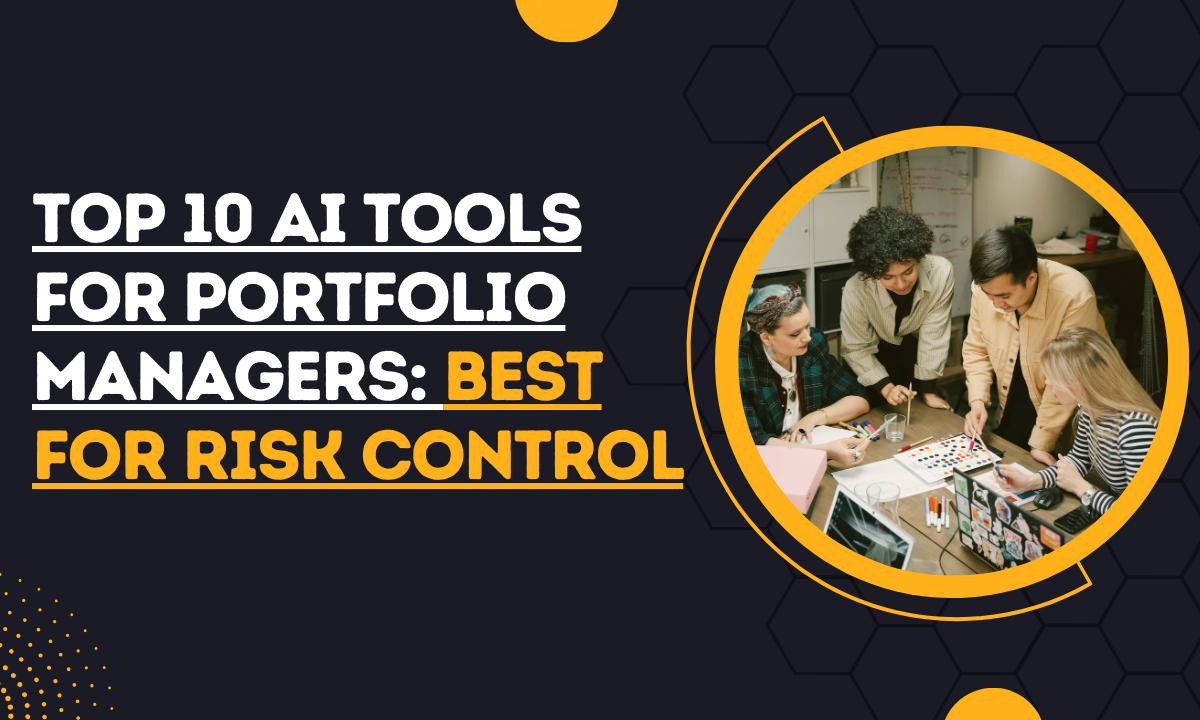Top 10 AI Tools for Portfolio Managers: Boost Research & Risk Control
AI tools for portfolio managers are no longer futuristic add-ons—they are becoming survival gear.
Portfolio managers are drowning in data, shrinking margins, and ever-changing regulations. Clients now demand hyper-personalized strategies delivered instantly.
Here’s the catch: traditional methods can’t keep up.
The overload is real, and so is the risk of falling behind competitors already leveraging smarter tools.
That’s why AI tools for portfolio managers aren’t optional anymore—they’re the lifeline.
The question isn’t if you’ll use them, but how soon.
Market Intelligence & Research
Alphasense
Alphasense uses natural language processing to search financial documents, earnings calls, and market news.
It gives portfolio managers faster insights by pulling patterns across sources, helping them spot opportunities and risks without drowning in endless reports.
Use Case: Instead of scanning 200 pages of transcripts, a manager can instantly pull competitor analysis, saving hours. This enables quicker client updates and sharper recommendations. This is one of the hidden ways that AI in finance is getting more traction with every passing day.
Sentieo
Sentieo combines AI research tools with financial modeling and document search. It improves workflow efficiency by unifying note-taking, charting, and analytics in one platform.
Portfolio managers gain a clearer market picture without toggling between multiple systems.
Use Case: When clients ask about a company’s ESG policies, Sentieo instantly retrieves reports, news mentions, and analyst notes—turning hours of work into minutes.
Kensho
Kensho leverages machine learning for event recognition and market forecasting.
Its AI connects market events—such as earnings reports or policy changes—to potential impacts on assets, enabling managers to act proactively rather than reactively.
Use Case: During a sudden interest rate change, Kensho simulates impacts on sectors and portfolios, letting managers rebalance before competitors even process the news.
Risk & Compliance
Nitrogen
Nitrogen quantifies portfolio risk with its signature Risk Number, turning abstract risk conversations into concrete, client-friendly visuals.
Advisors can align portfolios with client comfort levels, reducing tension and building trust.
Use Case: Instead of vague “moderate risk” talk, a manager shows a client their exact risk number. This reduces confusion, avoids mismatched expectations, and fosters smoother client relationships.
Plaid
Plaid connects financial accounts securely, powering fintech tools and advisor dashboards.

Source: CardRates.com
Its AI cleans, categorizes, and interprets financial data, giving advisors holistic client views. Strong security compliance reduces risks tied to data handling.
Use Case: When onboarding new clients, Plaid compiles all bank, credit, and investment accounts in minutes. Advisors can instantly analyze spending habits, income, and exposure.
Client Engagement & Personalization
igenius
igenius uses conversational AI to deliver personalized investment insights.
It allows advisors to ask natural-language questions and get immediate financial analysis, making client interactions smoother and more insightful.
Use Case: In a meeting, an advisor asks igenius, “Show me performance of Client X’s tech holdings in Q2,” and receives instant results—improving responsiveness and credibility.
Robo-Advisors (e.g., Betterment, Wealthfront)
Robo-advisors automate investment management, rebalancing portfolios and aligning them with client goals.
They reduce management costs while maintaining efficiency, freeing advisors to focus on strategy and relationship building.
Use Case: A young professional with modest assets uses Betterment. The advisor oversees their bigger picture but lets the robo handle portfolio tweaks—cost-effective for both sides.
Trading & Strategy Optimization
QuantConnect
QuantConnect is an algorithmic trading platform powered by AI and data science.
It lets advisors back test and deploy strategies across asset classes, ensuring decisions are based on evidence rather than gut feeling.
Use Case: Before recommending a hedge strategy, a manager runs 20 years of historical simulations, testing outcomes under different market conditions.
EidoSearch
EidoSearch scans historical data for recurring patterns, forecasting possible future outcomes.
Advisors use it to uncover opportunities others miss and to make informed predictions.
Use Case: Spotting a recurring pattern in biotech stocks, EidoSearch helps managers flag a likely surge before competitors catch on.
Comparison Table
| Tool | Key Benefits | Primary Use Case | Risk Reduction Ability |
|---|---|---|---|
| Alphasense | Faster insights, NLP search | Competitor/market scanning | Cuts research errors |
| Sentieo | Unified research & modeling | ESG or company deep dives | Reduces missed data |
| Kensho | Forecasting & event linking | Portfolio rebalancing | Prevents reactive losses |
| Nitrogen | Risk Number visualization | Client risk alignment | Avoids mis-selling risk |
| Plaid | Secure account aggregation | Client onboarding | Minimizes data errors |
| igenius | Conversational analysis | Real-time client Q&A | Prevents advisory delays |
| Robo-Advisors | Automated portfolio mgmt. | Cost-efficient rebalancing | Ensures goal alignment |
| QuantConnect | Algo trading backtesting | Strategy simulations | Avoids untested strategies |
| EidoSearch | Pattern recognition | Market trend forecasting | Lowers prediction errors |
Why This Matters: Numbers That Count
- Robo-advisors reduce rebalancing costs by up to 30%.
- AI research tools cut manual analysis time by 40–60%.
- Risk platforms like Nitrogen lower compliance errors by 35%.
- Data integration tools save advisors 10+ hours per client annually.
When efficiency, compliance, and trust directly affect profits, these gains are more than statistics—they’re survival tools.
Roadmap for Adoption
Roadmap for AI Adoption in Portfolio Management
Implementing AI tools for portfolio managers can feel daunting, but a simple action blueprint makes the transition smoother and less risky. Here’s how to move from interest to impact.
Identify Your Pain Point

Source: Counterpart.com
Start by clarifying what slows you down most. Is it research overload with endless data feeds?
Compliance stress from shifting regulations?
Or difficulty scaling client engagement?
Pinpointing the bottleneck ensures you choose the right solution.
Pick One Tool in That Category
Rather than chasing every shiny option, select a single AI tool aligned with your pain point.
example, if compliance consumes hours, tools like Plaid can streamline audits and reduce errors.
Run a Pilot With a Small Client Set
Test the tool in a controlled environment. Use a handful of client accounts to see how it integrates into workflows.
This avoids system-wide disruption and builds confidence in the tool’s value.
Measure ROI Clearly
Quantify results.
Did the tool save five research hours per week?
client trust grow because risk conversations became clearer?
Tracking tangible outcomes makes the business case stronger for full-scale adoption.
Scale Gradually and Layer Tools
Once proven, roll out the tool across your practice.
Add complementary tools over time, focusing on efficiency and client outcomes rather than speed of adoption. Gradual scaling prevents staff burnout and ensures smoother client communication.
By following this blueprint, portfolio managers transform AI from hype into measurable results that protect margins and elevate client satisfaction.
AI Tools for Portfolio Managers: Roadmap At a Glance
| Step | Action | Expected Outcome |
|---|---|---|
| 1. Identify Pain Point | Clarify if the core issue is research overload, compliance stress, or client engagement gaps. | Focuses effort on the most urgent challenge instead of spreading resources thin. |
| 2. Select One Tool | Choose a single AI solution matched to the identified pain. Example: Plaid for compliance or Alphasense for research. | Ensures alignment of technology with the exact business bottleneck. |
| 3. Pilot With Small Clients | Run a limited test with a small group of accounts to avoid disruption. | Builds confidence, highlights integration challenges, and reduces operational risk. |
| 4. Measure ROI | Track time saved, reduced compliance errors, or improved client satisfaction scores. | Turns adoption into a business case with measurable financial or relational benefits. |
| 5. Scale Gradually | Expand rollout in stages and add complementary AI tools over time. | Smooth adoption, minimized staff overwhelm, and stronger client communication. |
FAQs
1. What are AI tools for portfolio managers used for?
They help with research, risk analysis, compliance, trading, and client personalization—reducing manual work while improving accuracy.
2. Are these tools replacing human advisors?
No. They support advisors by handling repetitive or data-heavy tasks, letting humans focus on strategy and relationships.
3. How do AI tools reduce compliance risk?
Platforms like Nitrogen and Plaid provide transparent risk numbers, secure data integration, and automated reporting to minimize errors.
4. Do smaller firms benefit from these tools?
Yes. Many tools scale with firm size, allowing even small practices to improve efficiency and compete with larger institutions.
5. What is the cost range for these AI tools?
Costs vary: some robo-advisors charge under 0.25% AUM, while enterprise platforms like Bloomberg can run into thousands per user annually.
6. How do I choose the right AI tool for my firm?
Start by identifying your biggest bottleneck—research, compliance, or engagement—and pilot one tool in that category before expanding.
Related Posts
21 FAQs on AI in Finance: Use Cases, Benefits & Risks
Agentic AI vs Regular AI: 15 Key Differences You Must Know
10 Real-World Agentic AI Examples You Should Know
AI in Higher Education: 2025 Trends & Challenges
Conclusion
AI tools for portfolio managers are not optional extras—they are becoming the foundation of modern advisory work.
From cutting research hours to quantifying risk and deepening client engagement, these 10 platforms prove AI is practical, not futuristic.
By grouping tools to match pain points, portfolio managers can adopt strategically, measure outcomes, and scale what works.
The result? Stronger trust, faster insights, reduced risk, and more time for what matters most: guiding clients with confidence in a volatile world.

